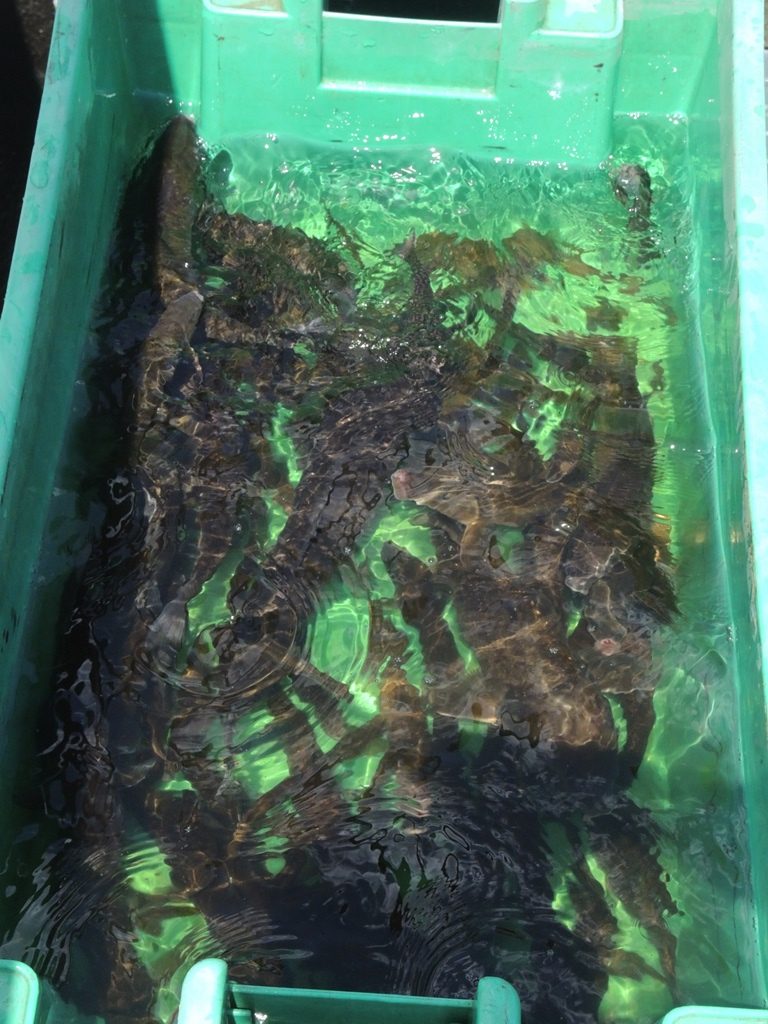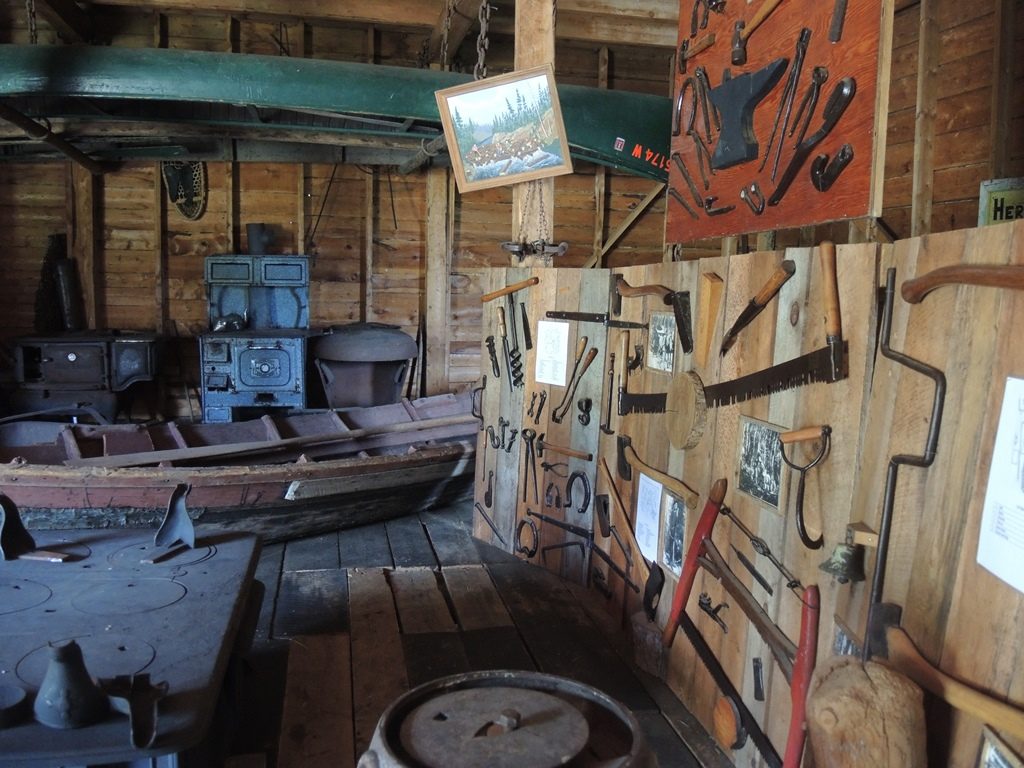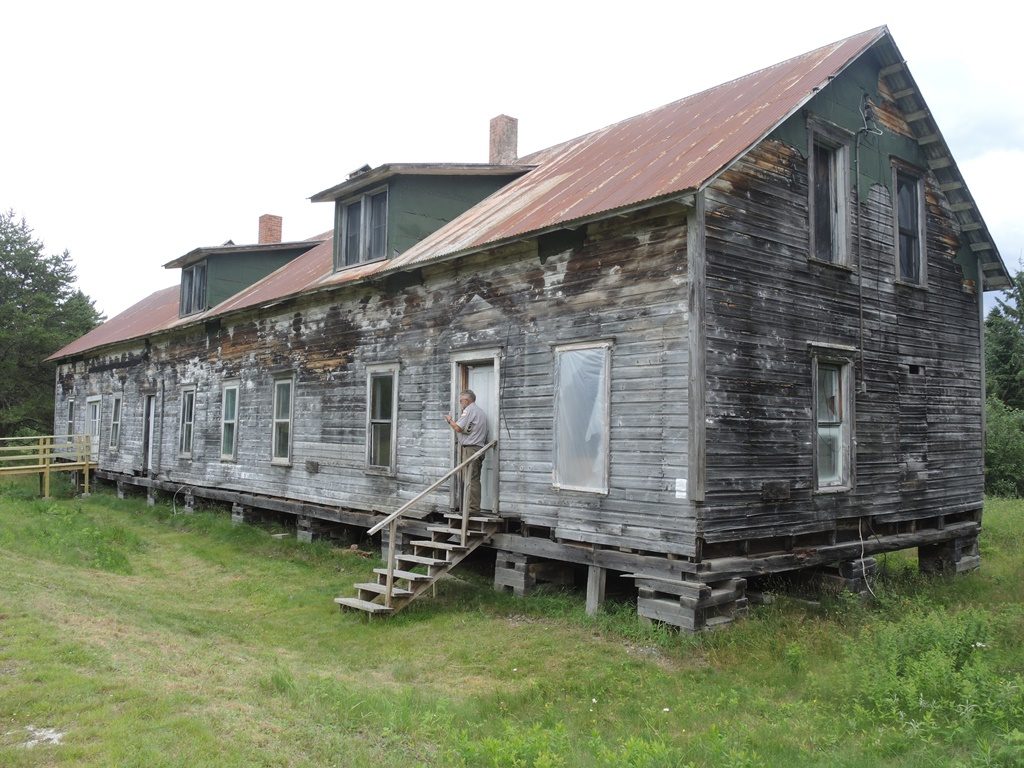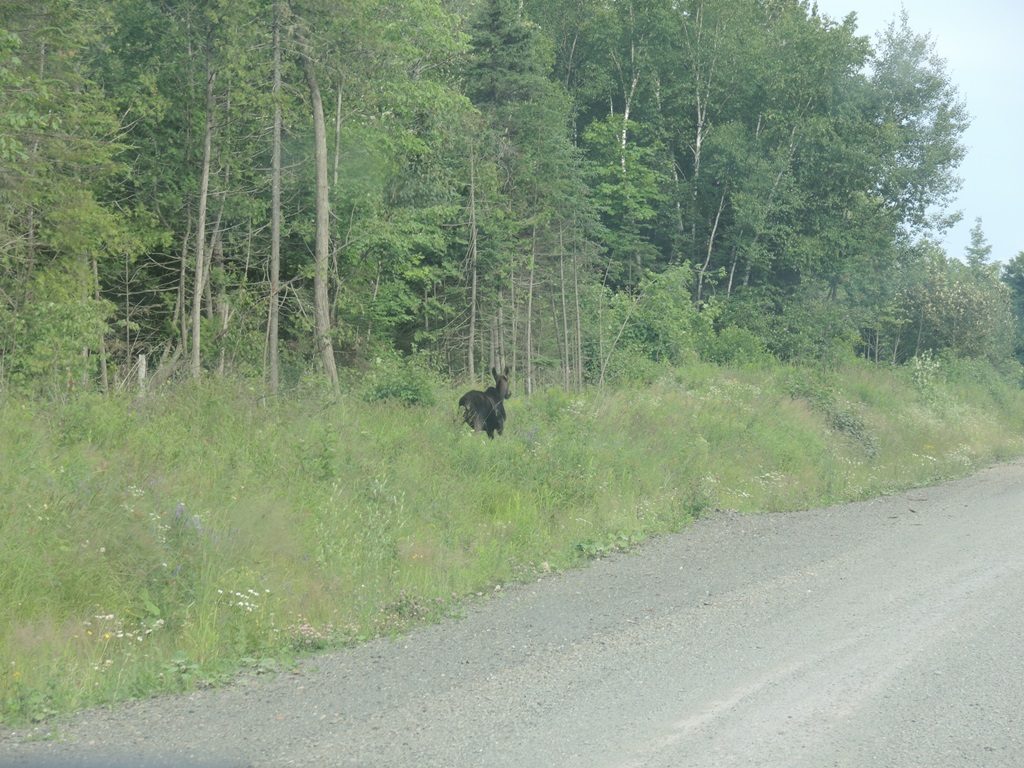July 22, 2016 at 1:39 pm
[caption id="attachment_1758" align="alignright" width="329"] IFW Fisheries Biologist Derrick Cote is down in one of the chambers of the Churchill Dam fishway, scooping out fish to weigh and measure[/caption]
[caption id="attachment_1766" align="alignleft" width="227"]
IFW Fisheries Biologist Derrick Cote is down in one of the chambers of the Churchill Dam fishway, scooping out fish to weigh and measure[/caption]
[caption id="attachment_1766" align="alignleft" width="227"] Allagash Ranger Bob Johnston closes the fishway gate with a hand crank. Closing the fishway gate allows water to flow to a trickle, allowing biologists to remove the fish to measure them.[/caption]
This Saturday, July 23, hundreds are expected to gather at Churchill Dam on the Allagash Wilderness Waterway to celebrate the 50th anniversary of the waterway. The day will feature a variety of events that showcase the history, heritage and uses of the waterway.
While the Allagash may be synonymous with canoeing, the waterway also boasts a wild brook trout fishery that attracts anglers from throughout the country and beyond. A fishway in Churchill dam allows IFW biologists the opportunity to monitor the brook trout population.
On Saturday as part of the celebration, IFW fisheries biologists Frank Frost, Jeremiah Wood and Derrick Cote will be on hand providing demonstrations on the Churchill Dam fishway and fishway trap.
The concrete dam was constructed in1997. It replaced an aging, leaking timber cribwork dam that made consistent paddling flows in the river unreliable. From a fisheries viewpoint, the old dam also made togue and lake whitefish management difficult because Big Eagle and Churchill Lakes water level would drop during the winter months, potentially drying out the fish’s eggs that had been laid in shallow water during fall spawning. Now during normal conditions, canoeable water flows are released each day in the summer from 8 a.m. to 12 p.m. and flows for good trout habitat are maintained as much as possible. In all these changes help IF&W better manage the wild trout and togue fisheries.
[caption id="attachment_1759" align="alignright" width="279"]
Allagash Ranger Bob Johnston closes the fishway gate with a hand crank. Closing the fishway gate allows water to flow to a trickle, allowing biologists to remove the fish to measure them.[/caption]
This Saturday, July 23, hundreds are expected to gather at Churchill Dam on the Allagash Wilderness Waterway to celebrate the 50th anniversary of the waterway. The day will feature a variety of events that showcase the history, heritage and uses of the waterway.
While the Allagash may be synonymous with canoeing, the waterway also boasts a wild brook trout fishery that attracts anglers from throughout the country and beyond. A fishway in Churchill dam allows IFW biologists the opportunity to monitor the brook trout population.
On Saturday as part of the celebration, IFW fisheries biologists Frank Frost, Jeremiah Wood and Derrick Cote will be on hand providing demonstrations on the Churchill Dam fishway and fishway trap.
The concrete dam was constructed in1997. It replaced an aging, leaking timber cribwork dam that made consistent paddling flows in the river unreliable. From a fisheries viewpoint, the old dam also made togue and lake whitefish management difficult because Big Eagle and Churchill Lakes water level would drop during the winter months, potentially drying out the fish’s eggs that had been laid in shallow water during fall spawning. Now during normal conditions, canoeable water flows are released each day in the summer from 8 a.m. to 12 p.m. and flows for good trout habitat are maintained as much as possible. In all these changes help IF&W better manage the wild trout and togue fisheries.
[caption id="attachment_1759" align="alignright" width="279"] Several brook trout and suckers are netted before being hoisted up to be measured.[/caption]
The fishway is an integral component of the dam structure, and essential for trout to access spawning areas in the fall but then return to Churchill and Big Eagle Lakes during the summer.
Below the dam, anglers flock to fish for wild trout when the water flows are diminished generally at noon each day. Chase Rapids boasts plenty of natural cover, some pools and some deep runs.
[caption id="attachment_1760" align="alignleft" width="330"]
Several brook trout and suckers are netted before being hoisted up to be measured.[/caption]
The fishway is an integral component of the dam structure, and essential for trout to access spawning areas in the fall but then return to Churchill and Big Eagle Lakes during the summer.
Below the dam, anglers flock to fish for wild trout when the water flows are diminished generally at noon each day. Chase Rapids boasts plenty of natural cover, some pools and some deep runs.
[caption id="attachment_1760" align="alignleft" width="330"] A tub full of trout, suckers, shiners, fallfish and creek chubs are ready to be measured.[/caption]
But as summer marches on, the water begins to warm, and the trout that are in the river seek relief from the heat by seeking deeper water. Below the rapids lies Umsaskis Lake, with a depth of 60 feet. Upriver, Churchill Lake is similar in depth, but upriver of that, Big Eagle Lake sinks to over 160 feet in depth, providing ideal shelter for summering trout.
The fishway provides passage through the dam, and periodically, IFW fisheries staff install a trap screen in order to capture trout, measure and weigh them, and release them.
The data gives biologists a snapshot of the brook trout population. Depending on what is learned, biologists can alter fishing regulations as needed to provide added protections or provide more opportunity.
Biologists first started taking measurements in 2000 and 2001. The first year 451 brook trout were collected. On average, they were 8.9 inches in length, and 6 ounces in weight. 2001 was similar, but the number of fish passing through dropped to 375 but increased in size to 9.9 inches and 6.2 ounces.
[caption id="attachment_1761" align="alignright" width="291"]
A tub full of trout, suckers, shiners, fallfish and creek chubs are ready to be measured.[/caption]
But as summer marches on, the water begins to warm, and the trout that are in the river seek relief from the heat by seeking deeper water. Below the rapids lies Umsaskis Lake, with a depth of 60 feet. Upriver, Churchill Lake is similar in depth, but upriver of that, Big Eagle Lake sinks to over 160 feet in depth, providing ideal shelter for summering trout.
The fishway provides passage through the dam, and periodically, IFW fisheries staff install a trap screen in order to capture trout, measure and weigh them, and release them.
The data gives biologists a snapshot of the brook trout population. Depending on what is learned, biologists can alter fishing regulations as needed to provide added protections or provide more opportunity.
Biologists first started taking measurements in 2000 and 2001. The first year 451 brook trout were collected. On average, they were 8.9 inches in length, and 6 ounces in weight. 2001 was similar, but the number of fish passing through dropped to 375 but increased in size to 9.9 inches and 6.2 ounces.
[caption id="attachment_1761" align="alignright" width="291"] IFW fisheries biologist Derrick Cote transfers a fallfish into the other tub as Allagash Ranger Bob Johnston records data on what was trapped. While trout are measured, weighed and marked, fish such as this fallfish are identififed and counted, then released back into the waterway.[/caption]
This year, biologists were eager to see what they would find, and it looks as though the number and condition of the trout continue to improve. IFW biologists have been tending the trap twice each week, and have been helped immensely by the Allagash Waterway Ranger staff who work at Churchill Dam.
With data collected through the first week of July, 419 brook trout had already moved through, eclipsing the yearly total for 2001 and nearing the total for 2000. Perhaps more notable was that even with the increasing numbers of trout, the trout are getting larger, now averaging 10.3 inches and weighing 6.8 ounces.
As the summer has progressed and water temperatures have increased, the number of trout passing through has decreased, but there are plenty of other fish that have passed through the trap including one togue, some round whitefish, common shiners, bullhead, suckers, creek chubs, fallfish and redbreast sunfish.
Saturday looks to be a great day with a variety of events to go along with the fishway demonstration including a bean hole bean dinner, homemade ice cream making and tasting, a Maine Forest Service helicopter water dropping demonstration, blacksmith demonstration and canoeable flows and canoe shuttle service all day.
[caption id="attachment_1764" align="alignleft" width="362"]
IFW fisheries biologist Derrick Cote transfers a fallfish into the other tub as Allagash Ranger Bob Johnston records data on what was trapped. While trout are measured, weighed and marked, fish such as this fallfish are identififed and counted, then released back into the waterway.[/caption]
This year, biologists were eager to see what they would find, and it looks as though the number and condition of the trout continue to improve. IFW biologists have been tending the trap twice each week, and have been helped immensely by the Allagash Waterway Ranger staff who work at Churchill Dam.
With data collected through the first week of July, 419 brook trout had already moved through, eclipsing the yearly total for 2001 and nearing the total for 2000. Perhaps more notable was that even with the increasing numbers of trout, the trout are getting larger, now averaging 10.3 inches and weighing 6.8 ounces.
As the summer has progressed and water temperatures have increased, the number of trout passing through has decreased, but there are plenty of other fish that have passed through the trap including one togue, some round whitefish, common shiners, bullhead, suckers, creek chubs, fallfish and redbreast sunfish.
Saturday looks to be a great day with a variety of events to go along with the fishway demonstration including a bean hole bean dinner, homemade ice cream making and tasting, a Maine Forest Service helicopter water dropping demonstration, blacksmith demonstration and canoeable flows and canoe shuttle service all day.
[caption id="attachment_1764" align="alignleft" width="362"] A plump Allagash brook trout. The top of the tailfin has been clipped, so biologists know if the fish has been recaptured.[/caption]
Visitors will also get a chance to experience the extensive history of the area with an open house of the village boarding house, a live demonstration of a Lombard log hauler (the precursor to the modern day skidder), bateau rides and history center tours.
It’s a once-every-fifty-years event, so make plans your plans to get there since not only is it possible that you might see some nice trout, you also will get a chance to relive some of the extensive history that makes the Allagash such a cultural and natural resource treasure.
[caption id="attachment_1771" align="aligncenter" width="519"]
A plump Allagash brook trout. The top of the tailfin has been clipped, so biologists know if the fish has been recaptured.[/caption]
Visitors will also get a chance to experience the extensive history of the area with an open house of the village boarding house, a live demonstration of a Lombard log hauler (the precursor to the modern day skidder), bateau rides and history center tours.
It’s a once-every-fifty-years event, so make plans your plans to get there since not only is it possible that you might see some nice trout, you also will get a chance to relive some of the extensive history that makes the Allagash such a cultural and natural resource treasure.
[caption id="attachment_1771" align="aligncenter" width="519"] The Churchill Dam History Center has a wonderful display of a bateau and tools of the time. There also is some machinery and a couple of vehicles at the center.[/caption]
[caption id="attachment_1767" align="aligncenter" width="857"]
The Churchill Dam History Center has a wonderful display of a bateau and tools of the time. There also is some machinery and a couple of vehicles at the center.[/caption]
[caption id="attachment_1767" align="aligncenter" width="857"] The old boarding house that borders the Allagash below Churchill Dam. The house used to be home to loggers, a post office and a school room.[/caption]
[caption id="attachment_1768" align="aligncenter" width="1024"]
The old boarding house that borders the Allagash below Churchill Dam. The house used to be home to loggers, a post office and a school room.[/caption]
[caption id="attachment_1768" align="aligncenter" width="1024"] The upstairs of the old boarding house used to hold dozens of bunks for woodsman working nearby. You can still see the discoloration made by their heads on the walls.[/caption]
[caption id="attachment_1770" align="aligncenter" width="1024"]
The upstairs of the old boarding house used to hold dozens of bunks for woodsman working nearby. You can still see the discoloration made by their heads on the walls.[/caption]
[caption id="attachment_1770" align="aligncenter" width="1024"] The car ride through the North Maine Woods offers the opportunity to see plenty of wildlife. On this day we saw several moose, multiple deer including one piebald deer, and a bear.[/caption]
The car ride through the North Maine Woods offers the opportunity to see plenty of wildlife. On this day we saw several moose, multiple deer including one piebald deer, and a bear.[/caption]
 IFW Fisheries Biologist Derrick Cote is down in one of the chambers of the Churchill Dam fishway, scooping out fish to weigh and measure[/caption]
[caption id="attachment_1766" align="alignleft" width="227"]
IFW Fisheries Biologist Derrick Cote is down in one of the chambers of the Churchill Dam fishway, scooping out fish to weigh and measure[/caption]
[caption id="attachment_1766" align="alignleft" width="227"] Allagash Ranger Bob Johnston closes the fishway gate with a hand crank. Closing the fishway gate allows water to flow to a trickle, allowing biologists to remove the fish to measure them.[/caption]
This Saturday, July 23, hundreds are expected to gather at Churchill Dam on the Allagash Wilderness Waterway to celebrate the 50th anniversary of the waterway. The day will feature a variety of events that showcase the history, heritage and uses of the waterway.
While the Allagash may be synonymous with canoeing, the waterway also boasts a wild brook trout fishery that attracts anglers from throughout the country and beyond. A fishway in Churchill dam allows IFW biologists the opportunity to monitor the brook trout population.
On Saturday as part of the celebration, IFW fisheries biologists Frank Frost, Jeremiah Wood and Derrick Cote will be on hand providing demonstrations on the Churchill Dam fishway and fishway trap.
The concrete dam was constructed in1997. It replaced an aging, leaking timber cribwork dam that made consistent paddling flows in the river unreliable. From a fisheries viewpoint, the old dam also made togue and lake whitefish management difficult because Big Eagle and Churchill Lakes water level would drop during the winter months, potentially drying out the fish’s eggs that had been laid in shallow water during fall spawning. Now during normal conditions, canoeable water flows are released each day in the summer from 8 a.m. to 12 p.m. and flows for good trout habitat are maintained as much as possible. In all these changes help IF&W better manage the wild trout and togue fisheries.
[caption id="attachment_1759" align="alignright" width="279"]
Allagash Ranger Bob Johnston closes the fishway gate with a hand crank. Closing the fishway gate allows water to flow to a trickle, allowing biologists to remove the fish to measure them.[/caption]
This Saturday, July 23, hundreds are expected to gather at Churchill Dam on the Allagash Wilderness Waterway to celebrate the 50th anniversary of the waterway. The day will feature a variety of events that showcase the history, heritage and uses of the waterway.
While the Allagash may be synonymous with canoeing, the waterway also boasts a wild brook trout fishery that attracts anglers from throughout the country and beyond. A fishway in Churchill dam allows IFW biologists the opportunity to monitor the brook trout population.
On Saturday as part of the celebration, IFW fisheries biologists Frank Frost, Jeremiah Wood and Derrick Cote will be on hand providing demonstrations on the Churchill Dam fishway and fishway trap.
The concrete dam was constructed in1997. It replaced an aging, leaking timber cribwork dam that made consistent paddling flows in the river unreliable. From a fisheries viewpoint, the old dam also made togue and lake whitefish management difficult because Big Eagle and Churchill Lakes water level would drop during the winter months, potentially drying out the fish’s eggs that had been laid in shallow water during fall spawning. Now during normal conditions, canoeable water flows are released each day in the summer from 8 a.m. to 12 p.m. and flows for good trout habitat are maintained as much as possible. In all these changes help IF&W better manage the wild trout and togue fisheries.
[caption id="attachment_1759" align="alignright" width="279"] Several brook trout and suckers are netted before being hoisted up to be measured.[/caption]
The fishway is an integral component of the dam structure, and essential for trout to access spawning areas in the fall but then return to Churchill and Big Eagle Lakes during the summer.
Below the dam, anglers flock to fish for wild trout when the water flows are diminished generally at noon each day. Chase Rapids boasts plenty of natural cover, some pools and some deep runs.
[caption id="attachment_1760" align="alignleft" width="330"]
Several brook trout and suckers are netted before being hoisted up to be measured.[/caption]
The fishway is an integral component of the dam structure, and essential for trout to access spawning areas in the fall but then return to Churchill and Big Eagle Lakes during the summer.
Below the dam, anglers flock to fish for wild trout when the water flows are diminished generally at noon each day. Chase Rapids boasts plenty of natural cover, some pools and some deep runs.
[caption id="attachment_1760" align="alignleft" width="330"] A tub full of trout, suckers, shiners, fallfish and creek chubs are ready to be measured.[/caption]
But as summer marches on, the water begins to warm, and the trout that are in the river seek relief from the heat by seeking deeper water. Below the rapids lies Umsaskis Lake, with a depth of 60 feet. Upriver, Churchill Lake is similar in depth, but upriver of that, Big Eagle Lake sinks to over 160 feet in depth, providing ideal shelter for summering trout.
The fishway provides passage through the dam, and periodically, IFW fisheries staff install a trap screen in order to capture trout, measure and weigh them, and release them.
The data gives biologists a snapshot of the brook trout population. Depending on what is learned, biologists can alter fishing regulations as needed to provide added protections or provide more opportunity.
Biologists first started taking measurements in 2000 and 2001. The first year 451 brook trout were collected. On average, they were 8.9 inches in length, and 6 ounces in weight. 2001 was similar, but the number of fish passing through dropped to 375 but increased in size to 9.9 inches and 6.2 ounces.
[caption id="attachment_1761" align="alignright" width="291"]
A tub full of trout, suckers, shiners, fallfish and creek chubs are ready to be measured.[/caption]
But as summer marches on, the water begins to warm, and the trout that are in the river seek relief from the heat by seeking deeper water. Below the rapids lies Umsaskis Lake, with a depth of 60 feet. Upriver, Churchill Lake is similar in depth, but upriver of that, Big Eagle Lake sinks to over 160 feet in depth, providing ideal shelter for summering trout.
The fishway provides passage through the dam, and periodically, IFW fisheries staff install a trap screen in order to capture trout, measure and weigh them, and release them.
The data gives biologists a snapshot of the brook trout population. Depending on what is learned, biologists can alter fishing regulations as needed to provide added protections or provide more opportunity.
Biologists first started taking measurements in 2000 and 2001. The first year 451 brook trout were collected. On average, they were 8.9 inches in length, and 6 ounces in weight. 2001 was similar, but the number of fish passing through dropped to 375 but increased in size to 9.9 inches and 6.2 ounces.
[caption id="attachment_1761" align="alignright" width="291"] IFW fisheries biologist Derrick Cote transfers a fallfish into the other tub as Allagash Ranger Bob Johnston records data on what was trapped. While trout are measured, weighed and marked, fish such as this fallfish are identififed and counted, then released back into the waterway.[/caption]
This year, biologists were eager to see what they would find, and it looks as though the number and condition of the trout continue to improve. IFW biologists have been tending the trap twice each week, and have been helped immensely by the Allagash Waterway Ranger staff who work at Churchill Dam.
With data collected through the first week of July, 419 brook trout had already moved through, eclipsing the yearly total for 2001 and nearing the total for 2000. Perhaps more notable was that even with the increasing numbers of trout, the trout are getting larger, now averaging 10.3 inches and weighing 6.8 ounces.
As the summer has progressed and water temperatures have increased, the number of trout passing through has decreased, but there are plenty of other fish that have passed through the trap including one togue, some round whitefish, common shiners, bullhead, suckers, creek chubs, fallfish and redbreast sunfish.
Saturday looks to be a great day with a variety of events to go along with the fishway demonstration including a bean hole bean dinner, homemade ice cream making and tasting, a Maine Forest Service helicopter water dropping demonstration, blacksmith demonstration and canoeable flows and canoe shuttle service all day.
[caption id="attachment_1764" align="alignleft" width="362"]
IFW fisheries biologist Derrick Cote transfers a fallfish into the other tub as Allagash Ranger Bob Johnston records data on what was trapped. While trout are measured, weighed and marked, fish such as this fallfish are identififed and counted, then released back into the waterway.[/caption]
This year, biologists were eager to see what they would find, and it looks as though the number and condition of the trout continue to improve. IFW biologists have been tending the trap twice each week, and have been helped immensely by the Allagash Waterway Ranger staff who work at Churchill Dam.
With data collected through the first week of July, 419 brook trout had already moved through, eclipsing the yearly total for 2001 and nearing the total for 2000. Perhaps more notable was that even with the increasing numbers of trout, the trout are getting larger, now averaging 10.3 inches and weighing 6.8 ounces.
As the summer has progressed and water temperatures have increased, the number of trout passing through has decreased, but there are plenty of other fish that have passed through the trap including one togue, some round whitefish, common shiners, bullhead, suckers, creek chubs, fallfish and redbreast sunfish.
Saturday looks to be a great day with a variety of events to go along with the fishway demonstration including a bean hole bean dinner, homemade ice cream making and tasting, a Maine Forest Service helicopter water dropping demonstration, blacksmith demonstration and canoeable flows and canoe shuttle service all day.
[caption id="attachment_1764" align="alignleft" width="362"] A plump Allagash brook trout. The top of the tailfin has been clipped, so biologists know if the fish has been recaptured.[/caption]
Visitors will also get a chance to experience the extensive history of the area with an open house of the village boarding house, a live demonstration of a Lombard log hauler (the precursor to the modern day skidder), bateau rides and history center tours.
It’s a once-every-fifty-years event, so make plans your plans to get there since not only is it possible that you might see some nice trout, you also will get a chance to relive some of the extensive history that makes the Allagash such a cultural and natural resource treasure.
[caption id="attachment_1771" align="aligncenter" width="519"]
A plump Allagash brook trout. The top of the tailfin has been clipped, so biologists know if the fish has been recaptured.[/caption]
Visitors will also get a chance to experience the extensive history of the area with an open house of the village boarding house, a live demonstration of a Lombard log hauler (the precursor to the modern day skidder), bateau rides and history center tours.
It’s a once-every-fifty-years event, so make plans your plans to get there since not only is it possible that you might see some nice trout, you also will get a chance to relive some of the extensive history that makes the Allagash such a cultural and natural resource treasure.
[caption id="attachment_1771" align="aligncenter" width="519"] The Churchill Dam History Center has a wonderful display of a bateau and tools of the time. There also is some machinery and a couple of vehicles at the center.[/caption]
[caption id="attachment_1767" align="aligncenter" width="857"]
The Churchill Dam History Center has a wonderful display of a bateau and tools of the time. There also is some machinery and a couple of vehicles at the center.[/caption]
[caption id="attachment_1767" align="aligncenter" width="857"] The old boarding house that borders the Allagash below Churchill Dam. The house used to be home to loggers, a post office and a school room.[/caption]
[caption id="attachment_1768" align="aligncenter" width="1024"]
The old boarding house that borders the Allagash below Churchill Dam. The house used to be home to loggers, a post office and a school room.[/caption]
[caption id="attachment_1768" align="aligncenter" width="1024"] The upstairs of the old boarding house used to hold dozens of bunks for woodsman working nearby. You can still see the discoloration made by their heads on the walls.[/caption]
[caption id="attachment_1770" align="aligncenter" width="1024"]
The upstairs of the old boarding house used to hold dozens of bunks for woodsman working nearby. You can still see the discoloration made by their heads on the walls.[/caption]
[caption id="attachment_1770" align="aligncenter" width="1024"] The car ride through the North Maine Woods offers the opportunity to see plenty of wildlife. On this day we saw several moose, multiple deer including one piebald deer, and a bear.[/caption]
The car ride through the North Maine Woods offers the opportunity to see plenty of wildlife. On this day we saw several moose, multiple deer including one piebald deer, and a bear.[/caption]